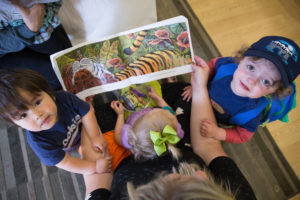Recap: Testing strategies to increase caregiver-child reading in the home: An implementation-science approach.
(By Janelle Williamson, March 11, 209) The March Crane Research Forum hosted Crane’s Executive Director, Dr. Laura Justice. Crane Research Forums are hosted monthly throughout the academic year and highlight Ohio State faculty and their research on children’s well-being.
Dr. Laura Justice has spent much of the pa st 20 years studying print knowledge in young children. Research shows that print knowledge is a prerequisite for reading. For young children with disabilities or low-resource homes, the acquisition of print knowledge can be difficult, which leads to long-term risks in reading achievement. Along with many colleagues, Dr. Justice created the Sit Together And Read (STAR) curriculum. STAR provides educators and caregivers print-rich books and guidelines on teaching print-knowledge.
st 20 years studying print knowledge in young children. Research shows that print knowledge is a prerequisite for reading. For young children with disabilities or low-resource homes, the acquisition of print knowledge can be difficult, which leads to long-term risks in reading achievement. Along with many colleagues, Dr. Justice created the Sit Together And Read (STAR) curriculum. STAR provides educators and caregivers print-rich books and guidelines on teaching print-knowledge.
Many studies were implemented to test the effectiveness of STAR. However, a re-occurring hurdle in these studies was the consistent loss of participants. Few are surprised by this loss of study participants. Attrition is alive and well in most academic research. In her presentation, Dr. Justice stressed that researchers need to stop guessing why people leave their studies. Instead, the cause of attrition needs to be answered scientifically.
Justice sought to answer the question, why don’t people do what they are supposed to? To answer this question, Dr. Justice and Dr. Jessica Logan identified time, self-confidence, empowerment and skill as the top four barriers to participant(s) completing a study. In an attempt to eliminate these barriers, they applied evidence-based techniques with the families in the study. For time barriers, families were given cash rewards. For self-confidence, caregivers received feedback. In regard to empowerment, text messages were sent to caregivers to encourage them. Finally, the barrier of skill was treated by modeling the implementation of STAR book reading. What was the effect of these interventions? Justice and Logan found that rewards and encouragement improved caregiver implementation. Modeling kept implementation about the same. Additionally, the feedback intervention led to a decrease in caregiver implementation.
Watch the full presentation here.
Read more about the history of STAR, and download STAR reading materials.
